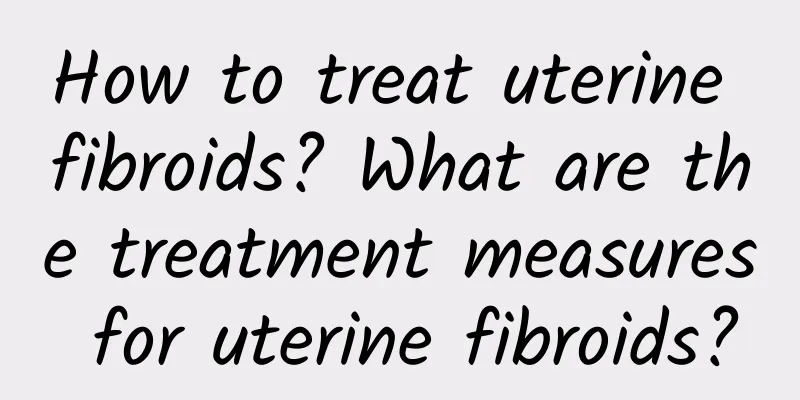How to treat uterine fibroids? Can uterine fibroids only be treated by surgery?

|
Experts point out that women over 30 should have a gynecological examination once a year. Firstly, it can detect uterine fibroids, cervical lesions, ovarian tumors and other diseases early; secondly, if they have already suffered from uterine fibroids, they can also monitor the growth and size of the uterine fibroids so that appropriate treatment measures can be taken in time. What are the symptoms of uterine fibroids? 40% of patients with uterine fibroids have no obvious clinical symptoms, but as long as you pay attention in daily life, you can still observe clues of uterine fibroids. The most common symptom is menstrual changes, including shortened cycles, increased menstrual flow, prolonged menstrual periods, irregular vaginal bleeding, etc. Because an extra tumor grows on the uterus, the abdomen is swollen, and there is a lump-like object in the middle of the lower abdomen when you touch it. When the bladder is full in the morning and pushes the uterus upward, it is easier to feel a very hard and irregular mass. Because the tumor compresses the bladder, frequent urination, urination disorders, urine retention, etc. may occur. Other symptoms include abdominal pain, back pain, lower abdominal distension, increased leucorrhea, infertility, secondary anemia, etc. If you find yourself with the above symptoms, you should go to the hospital for examination in time. To diagnose uterine fibroids, the first step is to inquire about the patient's medical history, including any history of excessive menstrual bleeding or irregular bleeding, or a lower abdominal mass. Gynecological examinations should be performed to find that the uterus is enlarged. Smaller fibroids, especially submucosal fibroids, are difficult to diagnose with gynecological examinations alone. Type B ultrasound can clearly show the size and location of fibroids and is one of the main means of diagnosing uterine fibroids. For people whose fibroids grow rapidly or continue to grow after menopause, the possibility of malignant changes should be considered. What are the treatments for uterine fibroids? The methods for treating uterine fibroids include expectant therapy, drug therapy, and surgical treatment. For patients with fibroids that are small, asymptomatic, without complications, and without degeneration, or perimenopausal patients, expectant therapy can be adopted, considering that the fibroids may regress or shrink after ovarian dysfunction, and regular follow-up observations (once every 3 to 6 months) in clinical and imaging aspects should be carried out. The treatment will be decided based on the review results. Conservative drug treatment can also be performed first, but the effect of drug treatment is uncertain. For patients with fibroids who are far from menopause and have physical symptoms such as heavy bleeding, or long-term excessive menstruation, long menstrual periods leading to anemia, or a small number of patients whose fibroids do not shrink but increase after menopause, and drug treatment is ineffective, surgical treatment should be considered. At present, the main surgical treatments for uterine fibroids include laparoscopy, coagulation knife and traditional transabdominal surgery. The laparoscopic minimally invasive technique for the treatment of uterine fibroids is the most popular among patients. During the operation, this technique only requires opening three 0.5-1 cm small holes in the patient's abdomen to remove the fibroids. After recovery, only 1 to 3 0.5-1 cm linear scars the size of a keyhole are left in the abdominal cavity. The surgery does not require laparotomy, has little trauma, and the patient recovers quickly, and can maintain the integrity of the female reproductive organs such as the uterus. It can be said that the wound is small and the pain is small. |
<<: What medicine is better for uterine fibroids? Treatment methods for uterine fibroids
Recommend
What you need to know about Gua Sha: It can help you get rid of local obesity
We often hear people say, "I have heatstroke...
Experts explain the causes of irregular menstruation to female friends
According to the latest clinical statistics, a la...
What is the secret of Jolin Tsai’s anti-aging at the age of 43? Nutritionist reveals: 3 unique dietary tips for controlling sugar levels
Queen Jolin Tsai was recently captured by netizen...
Five symptoms to determine whether you have uterine fibroids
What are the symptoms of uterine fibroids? Uterin...
Are you doing the right thing by eating sweet potatoes to lose weight? 3 key Q&A tips for you
Peel off the hot sweet potato, take a bite, and t...
Causes of hydatidiform mole
The occurrence of hydatidiform mole may be relate...
Loose skin after losing weight? With the help of plastic surgery, you can reshape your body and build firm, firm and slim muscles.
Weight loss has become one of the goals of modern...
How to tell if you have uterine fibroids
To determine whether you have uterine fibroids, y...
What foods are suitable for patients with cervical warts?
Cervical warts are a skin disease caused by a vir...
How to treat early cervical erosion in women? It is recommended to treat early cervical erosion in women in this way
Women's gynecological diseases are very compl...
Is it easy to have ectopic pregnancy if you have ovarian cysts? How can you cure it?
Does having ovarian cysts make you more susceptib...
Fat people can also suffer from anemia! Don’t take these 4 potential diseases lightly!
Fat people can also suffer from anemia! Most peop...
Analysis of several common methods for treating cervical hypertrophy
It is understood that the treatment of cervical h...
The secret to losing weight: diet + exercise! How to eat and exercise for three meals a day to double the weight loss effect?
There is no shortcut to losing weight, and you ca...
What causes irregular menstruation
Irregular menstruation is a common physiological ...









